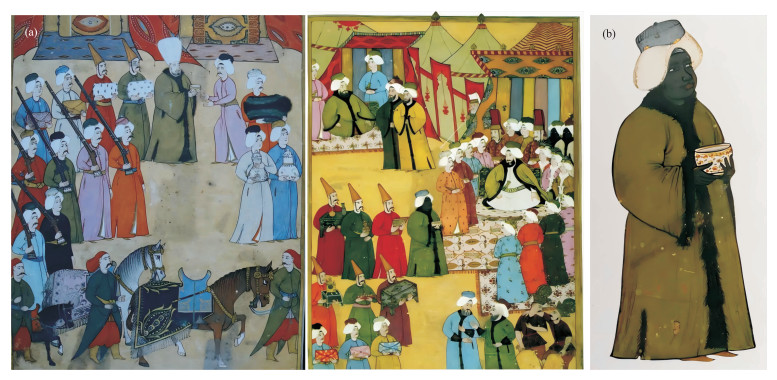
| Citation: | LU Wu, ZHANG Xiang, DAI Ziqi. Cultural Symbiosis and Aesthetic Reconstruction: When Chinese Porcelain Met the Gemstone Inlay Craft of Ottoman Empire in the 16th Century[J]. Journal of Gems & Gemmology, 2025, 27(2): 74-80. DOI: 10.15964/j.cnki.027jgg.2025.02.010 |
The Ottoman Empire, capitalizing on its geopolitical advantages, emerged as a pivotal center for East-West trade and reached its zenith in the 16th century. A substantial volume of Chinese porcelain was entered into the empire via the Silk Road trade network and collected by the Sultan's royal household. This influx inspired local craftsmen to redecorate these porcelains using a unique gem inlay technique. Today, these gem-inlaid porcelains, accounting for about 3% of the Chinese porcelain collection in Topkapi Palace Museum in Turkey, are typical examples of cultural symbiosis and aesthetic reconstruction within civilizational exchanges, which provieds a valuable empirical sample for "Belt and Road" historical research. This study focuses on 273 gem-inlaid porcelains from the Topkapi Palace Museum, employing observational method, along with historical literature review and iconographic studies.It analyzes the acquisition routes, craft aesthetics (including material features, decorative patterns, and inlay methods), and the reasons for redecoration. The aim is to explore the technical modifications, cultural translation logic, and social functions of Chinese porcelain by Ottoman craftsmen. The research reveals that Ottoman craftsmen utillized the "mesh covering method" and "star-like dotting method" for gem inlay, transforming the Chinese porcelain into imperial treasures integrating Islamic art elements. This process facilitated the functional localization (e.g. converting wine vessels into ablution utensils) and the reconstruction of cultural symbols (e.g. the symbolic meaning of tulip-patterned metal plates).Additionally, the study also differentiates between gem inlay and mounting techniques. The transformation of Chinese porcelain by Ottoman craftsmen not only enhanced the practicality and artistry of the objects but also provided a new perspective for studying the phenomenon of "cultural symbiosis and aesthetic reconstruction" in Sino-Western exchanges.
中国瓷器素以精湛工艺、独特造型和深厚文化内涵著称,并深受世界各地人们的青睐。16世纪的奥斯曼帝国处在鼎盛发展时期,作为当时伊斯兰世界的三大帝国之一,因其优越的地理位置成为了东西方贸易的重要枢纽。大量中国瓷器通过丝绸之路输入至奥斯曼帝国,不仅丰富了当地的文化生活,还激发了本土工匠的艺术创作灵感。奥斯曼工匠对中国外销瓷进行了独特的改装重饰,尤其是宝石镶嵌瓷器更是成为了奥斯曼宫廷瑰宝。现今这些宝石镶嵌瓷器几乎全部都典藏于土耳其托普卡帕宫博物馆中,是文明交流过程中文化共生与审美重塑的典型案例。本研究采用观察法,辅以历史文献考据与图像学分析,聚焦于16世纪奥斯曼帝国对中国外销瓷实施的改装重饰工艺及缘由,并阐述这些瓷器所承载的文化意义。
奥斯曼一世(首任苏丹,1299-1326年在位)带领部落建立了庞大的奥斯曼帝国。奥斯曼帝国存续时间长达600余年(1299-1923年),与当时的萨法维帝国、莫卧儿帝国共同形成了16-18世纪伊斯兰世界的三大帝国。1453年,穆罕默德二世(奥斯曼帝国第七位苏丹,1451-1481年在位)攻陷拜占庭帝国都城君士坦丁堡后,将其设立为奥斯曼新都城,并改名为伊斯坦布尔,同时还修建托普卡帕宫(又称托普卡匹、托普卡珀等)皇宫,供苏丹和皇室居住。至苏莱曼一世(奥斯曼帝国第十位苏丹,1520-1566年在位)时期,帝国实力达到鼎盛,统治区域地跨欧、亚、非三大洲,领土范围西起维也纳,涵盖巴尔干、黑海、克里米亚、高加索,东至中东以及波斯半岛,整个北非直至乍得湖都被纳入其版图。苏莱曼一世因其文治武功被享有“大帝”美誉。以丝绸之路为媒介,中国与该区域的关系大致可以分为三个历史时期:两汉-罗马时期、隋唐-拜占庭时期、元明清-奥斯曼时期[1]。元朝统治者不断完善欧亚大陆之间的交通系统,并专门设立了管理海上贸易的市舶司。奥斯曼帝国就处于这条重要贸易通道上,是古代陆上丝绸之路的亚洲终点以及陆、海丝绸之路的交汇点,同时与不同文明相互交融,与全世界保持着密切联系。两千多年前,中国的丝绸、瓷器、茶叶等商品正是经此输往欧洲[2],而当时控制黑海、马尔马拉海、东地中海、红海及印度洋部分海域的奥斯曼帝国通过各地各港口与中国保持间接贸易往来[3],成为地中海贸易的主体,欧洲威尼斯等商人想要生存下去,必须在此处换取东西方商品[4]。土耳其是最早支持共建“一带一路”的国家之一,现今,作为土耳其第一大城市的伊斯坦布尔依然是洲际交通和陆海贸易的重要枢纽,并以其优越的地理位置成为了“一带一路”的重要支点。
1914年奥斯曼帝国参与第一次世界大战战败后解体。1923年土耳其共和国成立,次年拥有近400年历史的托普卡帕宫被改造为博物馆。该馆现藏有逾万件中国瓷器,是我国境外收藏中国瓷器最多的博物馆,瓷器年代广阔,从13世纪到20世纪初几乎囊括了元(1279-1368年)、明(1368-1644年)、清(1644-1911年)三代生产的外销瓷器。托普卡帕宫博物馆有14-15世纪青瓷1 350多件,14世纪中期至19世纪青花瓷5 373件,白瓷31件,清代早期绿釉瓷器226件,康熙末年玫瑰粉和失透白珐琅彩瓷器527件,18世纪早中期的釉下涂蓝色基调、釉上镀金彩绘以及日本伊万里风格瓷器673件,还有低温单色釉覆盖的其他瓷器品种53件,以及数量极少、专供皇室的黄色瓷器。
更难得的是,托普卡帕宫博物馆还藏有约占总量3%的以宝石镶嵌的中国瓷器,属于苏丹皇室专用。如今已经不能准确地从官方文件中得知此类瓷器出现的时间以及数量。根据目前最早的一份宫廷档案(1680年)记载有382件,但据康蕊君等学者整理该馆现存273件宝石镶嵌的中国瓷器,与宫廷档案记载数量相差89件,其在三百多年的历史发展中遗落何处?据托普卡帕宫宫廷史料[5]记载,宝石镶嵌瓷器除了作为赏赐品赠给皇家成员、王公大臣以及外交使者,1738年的宫廷档案显示瓷器上的镶嵌宝石及贵金属可能因帝国财政危机而被拆解或熔铸货币,还有一些瓷器珍品则可能因宫殿不慎失火被毁坏[6];极少数瓷器则通过售卖的方式流出宫外,如波兰克拉科夫国家博物馆、大英博物馆及美国沃尔特斯艺术博物馆也藏有共计6件奥斯曼宝石镶嵌瓷器;还有文献[7]记载了公主陪嫁品中,有一部分镶有红宝石、绿宝石、珊瑚和金银饰件的碗、杯、盘、熏炉等瓷器。
作为海外藏有最多中国瓷器的托普卡帕宫,其收藏瓷器的获取途径多样:早期主要通过战利品、礼品或贡品所得;后期则以贸易、遗物充公为主,小部分由苏丹强令商人捐献或从民间强制征缴。
(1) 通过战利品获得瓷器。奥斯曼历代君主通过征伐西亚、北非地区,从拜占庭、波斯、大马士革、开罗、叙利亚、埃及等国缴获包含中国瓷器的战利品。上述国家与中国的交往历史源远流长,数千年来一直作为丝绸之路的中转站,因此其最早积累了不少中国瓷器。1514年赛里姆一世(奥斯曼帝国第九位苏丹,1512-1520年在位)攻陷了波斯大不里士皇宫,从中掳掠了大批珍品,其中包括景德镇瓷器64件[8]。
(2) 通过礼品或贡品获得瓷器。奥斯曼帝国每逢苏丹登基、大寿、大婚、病愈等重大仪式以及皇室生日、婚礼等庆典时刻,官员与附属国使节常以中国瓷器作为贺礼,迎合苏丹的喜好,目的是为其职务晋升,而来自中国的瓷器和丝绸则是最重要的礼品[9]。例如,图 1是1720年艾哈迈德三世(奥斯曼帝国第二十三位苏丹,1703-1730年在位)为王子举办割礼庆典时的献礼场景,白帽帕夏(土耳其语:paşa,是奥斯曼帝国行政系统里负责军事的最高指挥官)正手持一只宝石镶嵌的中国瓷器,递给粉红长袍的宫廷干事,随后被移交至中央献礼队伍的最前面的黑人宦官(负责苏丹日常生活起居的太监)。另外,苏莱曼一世(1520-1566年)与中国明朝嘉靖皇帝(1522-1566年)在位时间大致相同,其间奥斯曼帝国多次遣使朝贡嘉靖,中国古代朝贡制度有“厚往薄来”的特点,回馈的礼品中不乏精美瓷器[10]。
(3) 通过贸易获得瓷器。从赛里姆一世至苏莱曼一世,奥斯曼帝国占据了地中海地区近80%领土且拥有强大的海军舰队,基本控制了马尔马拉海、黑海、地中海、红海、印度洋亚丁湾、阿拉伯海波斯湾、马六甲海峡等海域和航线,海上交通颇为畅通,极大地促进了对外贸易和过境贸易。在此期间,大量中国瓷器、丝绸输入,奥斯曼帝国从往来贸易中获利颇丰[11]。明清两代中国与奥斯曼帝国有海陆两条交通路线,相较于陆地运输,海路更具优势。苏莱曼一世尤其钟情中国青花瓷,其在位期间,托普卡帕皇宫就新购置了200多件青花餐具,供其使用[12]。
(4) 通过遗产回流获得瓷器。17世纪到1839年期间奥斯曼帝国施行“Muhallefat”制度(土耳其语“Muhallefat”意为“遗产、遗物”[12])。按此法规定,皇室成员、官员遗产均归苏丹所有,即便瓷器残破,都需上缴国库。这是一种独特的财物回归制度,保障了珍贵器物能有效回流皇宫。
全球现存的宝石镶嵌瓷器几乎都典藏于托普卡帕宫博物馆。宝石镶嵌瓷器是奥斯曼宫廷根据本土民族文化特色对中国瓷器改装重饰的作品,其主要特色是由金属花托镶嵌宝石材料,再通过金属细丝嵌于瓷器表面。该装饰工艺诞生于苏莱曼一世(1520-1566年)统治时期,该时期首都伊斯坦布尔拥有画家、金匠、珠宝匠、铸剑师、乐手等多达1100个工人行会[13]。其中,珠宝行业因统治者的推崇发展达到鼎盛,伊斯坦布尔成为当时全球珠宝制造业中心。与苏莱曼一世同时代的英国女王伊丽莎白一世, 在其加冕仪式上所佩戴的黄金宝石王冠即出自奥斯曼帝国工匠之手[14]。
16世纪奥斯曼帝国宫廷手工艺生产机构创造性地将宝石镶嵌技术运用在中国瓷器上,文献记载[5]:“水倒入镶嵌有珍贵宝石的中国瓷碗中,在闪耀着光芒的红宝石的反射下,被染成耀眼的深红色。”奥斯曼宝石镶嵌瓷器的整个工艺过程严谨而精细,主要涵盖三个关键环节:(1)宝石材料切割——由经验丰富的锻造工匠和珠宝匠根据宝石材料特性,将其切割成方形、圆形、三角形等形状,符合后续镶嵌要求;(2)金属饰板加工——金匠主要采用一些延展性强的金银等材料制作各种形状和规格的金属饰板和金属丝。它们是宝石材料与瓷器之间的连接纽带,具有稳固和装饰的双重作用;(3)宝石与瓷器的镶嵌工艺——画家依据瓷器外形事先精心设计好装饰图案,雕刻家再依据图案在瓷器表面精准刻制凹槽,嵌工精密组合宝石、金属饰板及金属丝,并镶嵌于瓷器表面凹槽,严丝合缝。
此类宝石镶嵌瓷器最具代表的金属饰板样式是郁金香纹样(图 2)。郁金香在奥斯曼人信仰的伊斯兰教中,代表着“真主”的化身。在奥斯曼艺术文化中,郁金香是最常用、最受欢迎的花,郁金香图案可以用来装饰一切,包括建筑、织物等,甚至还包括墓碑、大炮等。穆罕默德四世(奥斯曼帝国第十九位苏丹,1648-1687年在位)曾颁布法令,要求所有的郁金香新品种必须注册和分类,并为此组建了“花卉专家委员会”。艾哈迈德三世(1703-1730年在位)统治时期也被称为“郁金香时期”,期间文学与艺术蓬勃发展,郁金香成为该时期许多绘画、歌曲和诗歌的灵感和主题。
依据作者对托普卡帕宫博物馆现藏的用以宝石镶嵌的中国瓷器的观察,这类瓷器工艺可分别概括为“网状包覆法”(图 3)和“星状点缀法”(图 4)。
“网状包覆法”是一种极具特色的技艺形式,带给人极具奢华又富有张力的视觉震撼。其核心是通过精细的工艺处理将金属丝线形成致密网状结构、紧密而规整地包覆于瓷器表面,托普卡帕宫博物馆的宝石镶嵌瓷器大多数都采用这一种方式。通常在这些宝石的外围多配饰花朵形状的金属饰板,如常见装饰元素——郁金香图案,在进行镶嵌工艺时会忽视瓷器本身所具有的图案和纹样,尽量选择器壁留白比较多的瓷器。这种工艺方法由于需在瓷器表面刻出镶嵌凹槽,易导致其釉面的完整性和光洁度受损,加上追求华丽的装饰效果所需的珠宝数量相对较多,故主要应用于瓷碗、瓷杯等形状较为规则的中小型器物上(图 3)。
“星状点缀法”则展现了另一种独特的工艺思路,其关键步骤是工匠们在瓷器表面精确地钻孔,并控制钻孔的深度以避免穿透器壁,以此保证瓷器基本功能完好。随后,工匠们将带有花梗的短柱状金属花托承载宝石,并借助特殊的黏合剂固定于预制孔位中,从而使宝石能够以零散星状分布于瓷器表面,在进行镶嵌工艺时一般会适当考量瓷器本身的图案和花纹,使宝石能够与图案进行有机结合,整体上呈现锦上添花的效果,不至于破坏器壁本身图案的美感。这种工艺方法在保证瓷器表面装饰效果的同时,极大程度地维护了其完整性和实用性。基于此,该工艺更多地被应用于瓷盘、瓷壶等类型的器物之上(图 4)。其较为简约、灵动装饰风格及所需宝石数量相对较少,与“网状包覆法”工艺形成了鲜明对比,二者共同丰富了宝石镶嵌瓷器工艺的多元性和艺术性。但从保存状况来看,运用“星状点缀法”镶嵌的宝石许多都已经从瓷器表面脱落,并在器壁上留下洞眼,两者相比较,似乎“网状包覆法”更能使珠宝牢固的镶嵌于瓷器表面。
16世纪奥斯曼帝国对中国瓷器实施了独特的改装重饰,其中宝石镶嵌成为了一种独特的工艺手段。这不仅反映了奥斯曼帝国对中国瓷器的深厚兴趣,还体现了多重复杂的文化和社会需求。
从实用功能出发,大多数苏丹相信中国瓷器(尤其是青瓷)能检验出食物中是否有毒[16],从精神象征出发,这些瓷器不仅代表了财富和权力,更是身份和地位的象征。通过在瓷器表面镶嵌红宝石、祖母绿、绿松石以及水晶、玛瑙、珍珠、珊瑚等珍贵之物,并在宫廷庆典和贵族聚会中展示,使拥有者的身份认同与社会地位得以进一步彰显,有时瓷器底部刻上专属铭文或者家族标识、所有者称号,更加强化其对器物的拥有权和地位。
这些瓷器以其精湛的工艺、独特的造型和丰富的文化内涵,深深吸引了奥斯曼皇室和贵族。对他们而言,中国瓷器不仅是实用器物,更是遥远东方文明的象征,文献中曾记载[15]苏丹对中国瓷器身后所代表的遥远文明表示惊叹或者尊重。奥斯曼人用宝石镶嵌这些瓷器,表达了他们对东方文明的崇拜和向往,同时也展示了他们与东方文化的紧密联系。
中国瓷器虽举世闻名,但其材质特性使其不可避免的存在易碎。在漫长距离的贸易运输过程中,由于路途颠簸、搬运不慎等诸多因素,瓷器遭遇磕碰损坏的情况屡见不鲜。对于完整的瓷器,奥斯曼工匠们针对瓷器易受损的关键部位,如口沿、颈部等区域,使用金属和珠宝(主要以延展性强的金银材料为主,珠宝镶嵌为辅)进行加固处理,有效地增强瓷器在日常使用中的抗碰撞能力。这种镶扣工艺(mounting)不仅延长了瓷器的使用寿命,还使其更加珍贵和独特。对于已损坏的瓷器,奥斯曼工匠们则利用金属材料对瓷器进行镶边、镶口、镶底、镶把手等修补手段,修复其功能并保留其美观性。需要强调的是,镶扣工艺与(宝石)镶嵌工艺手法上不完全相同,镶扣工艺更多是对器皿进行加固、修补、改造,而宝石镶嵌有加剧瓷器破裂的风险[15]。
奥斯曼工匠们也对中国瓷器的用途进行了在地化改造。根据奥斯曼帝国的文化和生活习惯,重新设计和改造瓷器用途,使其更加符合当地人的生活需求。中国酒文化源远流长,执壶、酒杯等瓷质酒器广受青睐,然而奥斯曼人饮酒是违反其所信奉的伊斯兰教教义的,自然这些酒器也就“无用武之地”,丧失了其原本的功能。例如,奥斯曼工匠将中国执壶逐渐转变为净手器具(图 5a);中国酒杯则与瓷盘一同配上金属与珠宝,转化为用于礼拜仪式的熏炉(图 5b),杯内的黄金内胆能防止瓷器被熏黑,而杯上的黄金顶罩,能使烟雾透过镂空缝隙进行释放、弥散。
托普卡帕宫博物馆藏宝石镶嵌的中国瓷器揭示了16世纪奥斯曼帝国在跨文化交流中展现的创造性转化能力。这种改装重饰的独特工艺既彰显了奥斯曼皇室与贵族的尊贵身份,又体现了他们对遥远东方文明的崇拜。需要说明的是,本文所述宝石镶嵌工艺和镶扣工艺手法上不完全相同,对瓷器加工的初始目的也不一样。奥斯曼工匠通过宝石镶嵌工艺实现了对中国瓷器的功能再造与文化转译,这种改造并非简单的技术叠加,而是通过审美重塑达成了文化认同的双向建构。这种将东方瓷器与伊斯兰装饰美学相融合的实践,不仅是文明交流过程中“文化共生与审美重塑”的典型案例,更为“一带一路”历史研究提供了器物层面的微观样本。
| [1] |
中国与土耳其: 小亚细亚两端的世界图景[J]. 文明, 2021(Z2): 6, 146-161.
Turkey-China: World atboth ends of Asia minor[J]. Civilization, 2021(Z2): 6, 146-161. (in Chinese)
|
| [2] |
李小成. 从汉代史书的"西域传"看古丝绸之路诸国之物产[J]. 唐都学刊, 2019, 35(4): 71-77.
Li X C. On the products of the countries along the ancient silk road based on the historical books The Western Regions Annals in the Han Dynasty[J]. Tangdu Journal, 2019, 35(4): 71-77. (in Chinese)
|
| [3] |
马文宽. 中国瓷器与土耳其陶器的相互影响[J]. 故宫博物院院刊, 2004(5): 78-96, 157.
Ma W K. The influence of Chinese porcelain in Turkey[J]. Palace Museum Journal, 2004(5): 78-96, 157. (in Chinese)
|
| [4] |
王晓明. 世界贸易史[M]. 北京: 中国人民大学出版社, 2009: 651.
Wang X M. World trade history[M]. Beijing: China Renmin University Press, 2009: 651. (in Chinese)
|
| [5] |
Taskin B. Topkapi Palace the Imperial Harem — House of the Sultan[M]. Istanbul: BKG Yayinlari, 2012: 354-355.
|
| [6] |
Efendi S M. Seranic biography[M]. Istanbul: Unknown publisher, 1989: 90.
|
| [7] |
爱赛·郁秋克. 伊斯坦布尔的中国宝藏[M]. 欧凯, 译. 伊斯坦布尔: 土耳其外交部, 2010: 126.
Yutyuk A. A Chinese treasure in Istanbul[M]. Ou K, translated. Istanbul: Ministry of Foreign Affairs of Turkey, 2010: 126. (in Chinese)
|
| [8] |
曾涛. 论元明时期青花瓷在西亚北非的传播及其影响[D]. 太原: 山西师范大学, 2022.
Zeng T. Spread of the blue and white porcelain in West Asia and North Africa during the Yuan and Ming eras[D]. Taiyuan: Shanxi Normal University, 2022. (in Chinese)
|
| [9] |
张向荣. 奥斯曼帝国宫廷生活中的中国瓷器[J]. 北大区域国别研究, 2024(2): 128-139.
Zhang X R. Chinese porcelain in the Ottoman courtlife[J]. PKU Journal of Area Studies, 2024(2): 128-139. (in Chinese)
|
| [10] |
张廷玉. 明史[M]. 北京: 中华书局, 1974: 8 626-8 627.
Zhang T Y. The history of Ming Dynasty[M]. Beijing: Zhonghua Book Company, 1974: 8 626-8 627. (in Chinese)
|
| [11] |
海斯, 穆恩, 韦兰. 世界史[M]. 冰心, 译. 北京: 生活·读书·新知三联书店, 1975.
Hayes C J, Moon P T, Wayland J W. World history[M]. Bin X, translated. Beijing: SDX Joint Publishing Company, 1975. (in Chinese)
|
| [12] |
裴度, 葛建军. 土耳其托普卡比王宫博物馆收藏的中国瓷器[J]. 收藏家, 1997(5): 60-61.
Pei D, Ge J J. The collection of Chinese porcelain in the Topkapi Palace Museum of Turkey[J]. Collector, 1997(5): 60-61. (in Chinese)
|
| [13] |
Dankoff R, Kim S. An Ottoman traveller, selections from The Book of Travels of Evliya Celebi[M]. London: Eland Publishing, 2011: 437.
|
| [14] |
Durucu N. Suleiman the Magnificent: An Ottoman sultan and jeweler[J]. Adornment, The Magazine of Jewelry & Related Arts, 2017, 11(1): 3-16.
|
| [15] |
Krahl R, Erbahar N, Ayers J, et al. Chinese ceramics in the Topkapi Saray Museum Istanbul: A complete catalogue[M]. New York: Sotheby Parke Bernet Pubns, 1986.
|
| [16] |
Galland A. Istanbul'a ait günlük Hatιralar (1672-1673)[M]. Ankara: Türk Tarih KurumuYayιnlarι, 2018: 20.
|